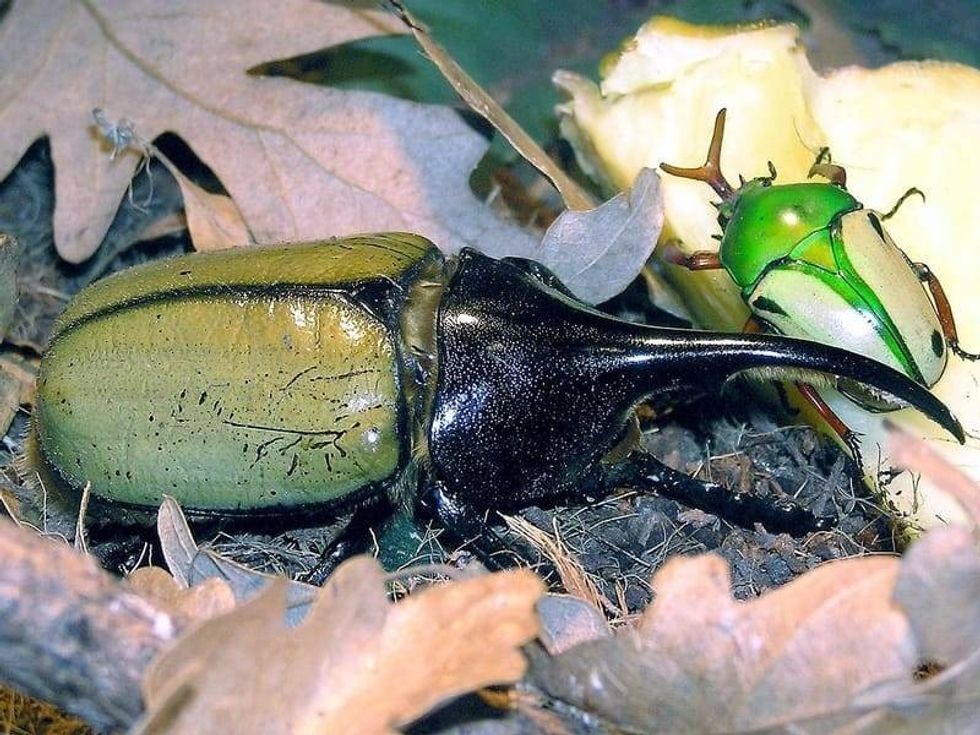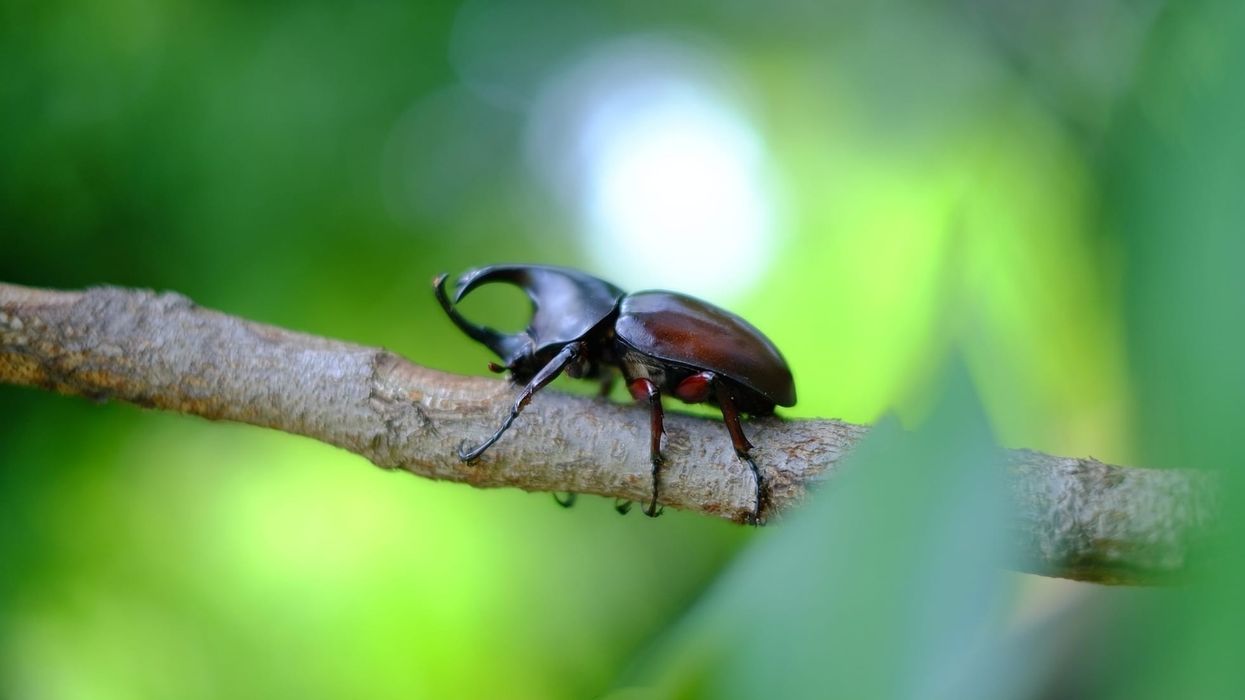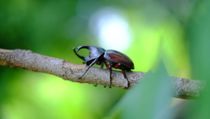Fun Hercules Beetle Facts For Kids
The Hercules beetle (Dynastes hercules) is known as 'Hercules' due to its great strength. Hercules beetle (Dynastes hercules) are a species of rhinoceros beetle belonging to genus dynastes, family scarabaeidae, subfamily dynastinae.
It is the longest extant species of beetle in the world and the largest flying insect in the world. Hercules beetle (Dynastes hercules) is natively found in the rainforest of South America and Central America.
It is one of the sub species of rhinoceros beetle much like the eastern Hercules beetle (dynastes tityus). They are found on the forest floor foraging for food amongst the fallen leaves and other such parts.
This fallen foliage helps the Hercules beetle (Dynastes hercules) to hide. There are 13 known species of Hercules beetles found in these forests. The male beetle is known to reach a size of seven inches in length.
The males are identified by their enormous horn-like pincer, which protrudes from their forehead whereas females do not have any horns. These longhorns can grow bigger than their body.
The horns are used by the males to resolve disputes. Female Hercules beetles don't have this horn.
The Hercules beetle (Dynastes hercules) is the strongest creature on the earth, as it carries weight 850 times its body size. Due to constant deforestation and rising pollution, the Hercules beetle population is in constant decline.
The body of the males is black in color with elytra, or the outer shell is yellow or olive green colored. After reading this article on Hercules beetle, do check out our other articles on click beetle and atlas beetle.
Hercules Beetle Interesting Facts
What type of animal is a Hercules beetle?
The Hercules beetle (Dynastes hercules) is a type of insect. It is one of the largest insects in the world.
As the Hercules beetle (Dynastes hercules) name suggests, it can carry almost 850 times the weight of its body as it is incredibly strong. It is a sub-species of rhinoceros beetle with genus Dynastes like the eastern Hercules beetle (Dynastes tityus).
What class of animal does a Hercules beetle belong to?
The Hercules beetles belong to the Insecta class of animals. Hercules beetle (Dynastes hercules) are found in the rainforest of South America and Central America. They belong to Family Scarabaeidae Subfamily Dynastinae.
How many Hercules beetles are there in the world?
The exact number of Hercules beetles in the world is a little difficult to calculate or project. The species of Hercules beetle (Dynastes hercules) is under threat due to the loss of its natural habitat.
The major deforestation and pollution is a major reason for the decline in the number of this species of rhinoceros beetle (Family Scarabaeidae Subfamily Dynastinae)
Where does a Hercules beetle live?
The Hercules beetles are found in the tropical rainforest of South and Central America. Hercules beetle (Dynastes hercules) were introduced in the arid weather of North America, too. However, the loss of these forests is directly leading to the decline in the number of this species of rhinoceros beetles ((Family Scarabaeidae Subfamily Dynastinae.) in these regions.
What is a Hercules beetle's habitat?
The Hercules beetle (Dynastes Hercules) is found from southern Mexico to Bolivia in the mountainous as well as lowland tropical rain forests. This species of rhinoceros beetles are also found in the Lesser Antilles, Trinidad and Tobago, Brazil, Ecuador, Colombia, and Peru.
It is said that this species of rhinoceros beetles originated in the South American continent. Hercules beetle (Dynastes hercules) are nocturnal creatures that forage for food during the night time.
Who do Hercules beetles live with?
Some people keep Hercules beetles as a pet. Multiple female beetles can be kept together with a single male beetle. But it is not advisable to keep two male Hercules beetle species together as they are aggressive towards each other.
How long does a Hercules beetle live?
The Hercules beetle (Dynastes hercules) goes through a complete metamorphosis in its life span. Scientists have observed the Hercules beetle lifespan in laboratory conditions. The egg has an incubation period of 27 days.
After which it will go through three stages (known as instar) of complete metamorphosis. This larval stage may last up to two years. It has a yellow body and a blackhead. The first instar stage is of 50 days, the second instar stage is of 56 days, and the third stage is 450 days.
After which, the pupal stage begins, which is for 32 days. At this stage, it will transition into an adult. Adult beetles can survive from three to six months in captivity.
How do they reproduce?
The males of Hercules beetle fight to win possession and mating rights with a female. They use their large horns like pincers to settle a dispute. These fights can cause significant damage to this species of rhinoceros beetle.
The male beetles attempt to grab and pin the opponent between the cephalic and thoracic horns to life and throw them. The winner gets to mate with the female. These beetles are polygynandrous.
Then the mating commences pretty quickly and may last for an hour. The female can lay 100 eggs. It may take almost 27 or more days before they hatch.
What is their conservation status?
The conservation status for a Hercules beetle (Dynastes Hercules) is listed as Not Extinct. The loss of the entire ecosystem due to deforestation and rising air and water pollution has led to a major decline in its population. But still this species of rhinoceros beetle is not facing any threats to its existence.
Hercules Beetle Fun Facts
What do Hercules beetles look like?
The adult Hercules beetle (Dynastes hercules) looks like a soldier ready for combat due to its single protruding horns from its forehead. The horns can be bigger if not the same size as its body.
Only the male Hercules beetle has this horn while the females do not have this horn.
Hercules beetle (Dynastes hercules) have bright yellow or olive green colored shells on an almost black body. Adult Hercules beetle is able to undergo color change for its elytra between yellow and black within a matter of few minutes.

How cute are they?
The Hercules beetles are definitely different-looking creatures, especially the males with their pincer-like horns. They are also one of the largest insects on the plants.
There have been reports that some male beetles have grown seven inches in length. Their horns are one of the standout features of their appearance. The horn is present only in males of this species.
How do they communicate?
The Hercules beetle (Dynastes hercules) communicates through a mix of chemoreception, sight, and mechanical perception. The adult beetles make a huffing sound which is made by stridulating their abdomen against their outer shell or elytra to warn the predators.
How big is a Hercules beetle?
The Hercules beetles are one of the largest flying insects in the world. They are known as Hercules beetles because of their strength. They are bigger than many beetles in the world.
How fast can a Hercules beetle run?
The Hercules beetles must be a fast runner, but it is also a forager of food. It hides in the dead leaves and rotting fruit mass on the forest ground looking for food. The Hercules beetle flight speed is not very fast at an average is around 1 m/s and 4 m/s.
How much does a Hercules beetle weigh?
The Hercules beetle weighs up to 0.28-0.30 lb. As per its size, the weight of the beetle may vary. Also, at the various stages of complete metamorphosis the weight would be different. Hercules beetle strength is amongst the strongest insects species.
What are their male and female names of the species?
The species does not have any separate names for its males and females. The males are known as male Hercules beetle and females are known as female Hercules beetle.
What would you call a baby Hercules beetle?
The Hercules beetle baby also doesn't have a separate name. The young one is known as a Hercules beetle larvae as soon as it is born and thereafter it is known as a young Hercules beetle.
What do they eat?
The Hercules beetles eat rotting wood and rotting or fresh fruits. At the larvae stage, the species stays in the rotting wood or plants to gather nutrition from and survive in it. They eat other plant matter, wood material, or smaller insects too.
Are they poisonous?
Due to its horn, many people assume that the Hercules beetle bite may be poisonous. That is not the case. These insects are neither poisonous nor does it bite.
Would they make a good pet?
The Hercules beetles can be kept as pets easily. If you can create their habitat of tropical rainforest in a medium-sized container, you can keep them in it, and it can survive well there.
As it is not a poisonous creature, it would be a good idea to keep them as pets. They play an important part in the ecosystem by eating the rotting plants and fruits. It would be a good idea to feed them food scraps from the kitchen.
Did you know...
Apart from the South American Hercules beetle found in the rainforest, there are two more Hercules beetles are called Eastern Hercules beetles and Western Hercules beetles. The eastern Hercules beetle can be easily located in the eastern part of North America, and the western Hercules beetle is found in the western part of North America.
When in captivity, the male Hercules beetles are observed lifting and slamming each other into the ground until one gets tired.
The Hercules beetles are sexually dimorphic, which means only males have horns.
After going through the metamorphosis for two to three months, it will break out of its old exoskeleton and then wait for the new shell to harden for a couple of hours before going out.
At the initial stage, the Hercules beetles are beneficial contributors to the national ecosystem, as they are sapro xylophagous, which means they eat the rotting wood that leads to biodegradation and cycling of nutrients in the environment.
Hercules beetle life cycle starts from Hercules beetle grub and ends as the adult Hercules beetle. Their entire lifespan ranges between three to six months.
They are not harmful to humans or crops in agricultural areas.
The male Hercules beetles are very aggressive towards each other not only in the quest of getting mating rights with the females but also in general.
The mating season for Hercules beetle is during the rains.
The adult stage of the Hercules beetle lasts for three to six months only.
It is believed that the Hercules beetles can detect vibrations. The male beetles when placed near to a female beetle will immediately go towards her and seek her out. They are known to communicate through strong sexual pheromones.
Most information about the life of Hercules beetles is collected under artificial conditions or in laboratory observation.
Hercules beetle eyes have compound structure and chewing mouthparts. Their eyes are located on the side of the head, slightly below the lower horn.
How much can a Hercules beetle lift?
The Hercules beetle is known to lift up to 850 times its weight. As per actual measurement on a much smaller species, it can really lift 100 times its weight and can barely move or 40 times for about 10 minute.
Where can I find a Hercules beetle?
The Hercules beetle can be found across the rainforest of south and central America and in the southern U.S. from Florida to Texas. The species was introduced to the drier climate of the United States and has done well so far.
Here at Kidadl, we have carefully created lots of interesting family-friendly animal facts for everyone to discover! Learn more about some other arthropods including blister beetle, or water beetle.
You can even occupy yourself at home by drawing one on our hercules beetle coloring pages.
We Want Your Photos!
More for You
Bachelor of Science specializing in Computer Science

Christian MbaBachelor of Science specializing in Computer Science
Christian Mba is an experienced blogger and content writer with over a decade of experience. He holds a Bachelor of Science degree in Computer Science from Nigeria and has a keen interest in Python programming. Along with his writing and blogging expertise, he is also an SEO specialist with more than six years of experience. Chris, as he is commonly known, has a passion for music and enjoys playing the piano.
Disclaimer
1) Kidadl is independent and to make our service free to you the reader we are supported by advertising. We hope you love our recommendations for products and services! What we suggest is selected independently by the Kidadl team. If you purchase using the Buy Now button we may earn a small commission. This does not influence our choices. Prices are correct and items are available at the time the article was published but we cannot guarantee that on the time of reading. Please note that Kidadl is a participant in the Amazon Services LLC Associates Program, an affiliate advertising program designed to provide a means for sites to earn advertising fees by advertising and linking to Amazon. We also link to other websites, but are not responsible for their content.
2) At Kidadl, we strive to recommend the very best activities and events. We will always aim to give you accurate information at the date of publication - however, information does change, so it’s important you do your own research, double-check and make the decision that is right for your family. We recognise that not all activities and ideas are appropriate for all children and families or in all circumstances. Our recommended activities are based on age but these are a guide. We recommend that these ideas are used as inspiration, that ideas are undertaken with appropriate adult supervision, and that each adult uses their own discretion and knowledge of their children to consider the safety and suitability. Kidadl cannot accept liability for the execution of these ideas, and parental supervision is advised at all times, as safety is paramount. Anyone using the information provided by Kidadl does so at their own risk and we can not accept liability if things go wrong.
3) Because we are an educational resource, we have quotes and facts about a range of historical and modern figures. We do not endorse the actions of or rhetoric of all the people included in these collections, but we think they are important for growing minds to learn about under the guidance of parents or guardians.







